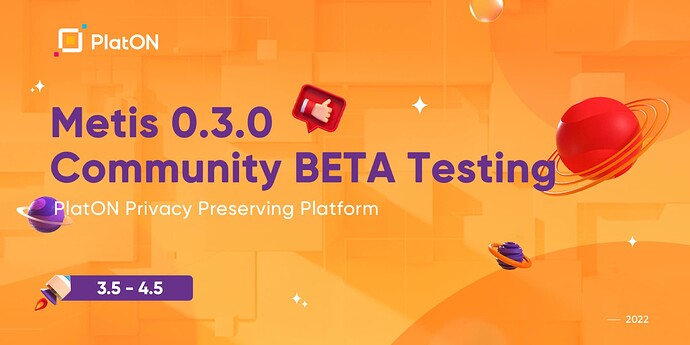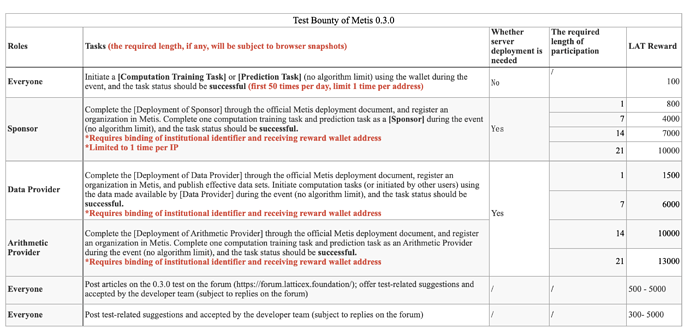Dear members of the PlatON community, we are excited to announce that the community testing of Metis version 0.3.0 will begin on March 5, which aims to help you get familiar with the new features of Metis. The Test Bounty offers detailed testing documents, as well as incredible rewards. The following contains the latest updates of the new version:
Challenging Task Overview (must-read)
Overview (must-read)
Dear members of the PlatON community, today we will first briefly introduce the Test Bounty and its purpose.
Metis is the middle layer of the three-layered PlatON network, and also the first of the three major targets of PlatON. As a major milestone of the PlatON network, it aims to build a decentralized data-sharing, privacy-preserving computation network that brings together data users, data owners, algorithm developers, and arithmetic providers.
We thank you for your continued support of our testing events, including valuable suggestions and bug reports, as well as your constant encouragement. During the one year from version 0.2.0 (the first community testing) to version 0.3.0, we have created the matching Metis scenarios (available in version 0.3.0) for data users, data owners, algorithm developers, and arithmetic providers.
[Key Takeaways] The testing comes with great difficulties. To help you go through the testing, the Test Bounty is divided into different parts that correspond to the roles in Metis.
For those of you who never deployed a node before or do not have the time for deployment, [Everyone]」will be the best option, which allows you to experience Metis as a [Data User]. Plus, you can get rewards by completing the test, drafting test documents, or posting test-related suggestions on the forum!
If you are experienced in node deployment or software development, we strongly encourage you to take the three other kinds of services as a Sponsor, Data Provider, or Arithmetic Provider. The longer you run the node, the more rewards will be available!
The 0.3.0 test does not yet include Token in the circulation process of the network and data. Some of you may wonder when LAT will be included in the running of Metis.
Please stay tuned and find out next time ![]()
Link
Metis manages its users in a decentralized manner. To log in to the platform, you’ll only need a crypto wallet that supports MetaMask extension, without the need to register an additional account. Log in to Metis at https://test.technocore.network.
Help Documentation for Testing Metis Version 0.3.0
Help Documentation for the Privacy-preserving Computation Network: Help Documentation for the Moriae Privacy-preserving Computation Network.md
Metis Deployment Document: Metis-Deploy/README_EN.md at ansible · Metisnetwork/Metis-Deploy · GitHub
Common problems and solutions in deployment (FAQ): Metis-Deploy/FAQ_EN.md at ansible · Metisnetwork/Metis-Deploy · GitHub
Rewards of the Metis Test Bounty
Complete the following tasks to collect rewards of the Test Bounty. The rewards will be distributed to the address used for completing the task.
Please first read the following definitions to better understand the event:
Sponsor: Node deployment is required. When someone uses your node to initiate tasks, you’ll be regarded as a Sponsor.
Data Provider: Node deployment is required. The task of a Data Provider is to deploy data nodes and upload data sets. When someone uses your data to initiate computation tasks, you’ll be regarded as a Data Provider.
Arithmetic Provider: Node deployment is required. The task of an Arithmetic Provider is to deploy compute nodes. When someone uses your computing power to initiate computation tasks, you’ll be regarded as an Arithmetic Provider.
About the Bounty:
[Required for node deployment! ] To ensure accurate reward statistics, please bind the organization ID and IP immediately after deploying the node!
Binding link: Privacy Computing Platform Metis 0.3.0 Test - Binding Organization ID and IP.
P.S. Since the tasks of the data provider and the computing provider include the task content of the task initiator, i.e. the deployed data and computing nodes must complete the deployment of the scheduling nodes of the task initiator, the task initiator rewards will not be issued repeatedly for completing the tasks of the task initiator, the data provider and the computing provider, but will be issued according to the reward criteria of the data provider.
P.S. Since the Sponsors task are included by Data Provider tasks and Arithmetic Provider tasks (the data/computing nodes deployed must go through node deployment, which is the task of Sponsors), participants who completed the tasks of Data Providers and Arithmetic Providers will not receive the Sponsor reward for the second time. Instead, their reward will be the same as the reward for completing Data Provider tasks.
Update at on March 8 [Reward budget increased! ]
Considering the great passion of community members for this event, we have added 200,000 LAT as an extra reward, and made the following modifications to the reward details:
**As of 8:00(UTC) on March 8, the nodes that have been successfully deployed and bound with the ID, IP, port and address of the institution will be rewarded according to the above table. **
**For nodes that are successfully deployed and bound after 8:00(UTC) on March 8, the remaining prize pool, if sufficient, will be distributed in full according to the original reward plan; if not, it will be distributed with the test duration as a weight. **
p.s. As of March 8, the prize pool remains sufficient.
Contact information: Participants in the node deployment can join the group chat Telegram: Join Group Chat to check with us whether the id is successfully bound or ask other test-related questions.
Major Updates:
Compared to the version 0.2.0 test, the present test covers the following updates:
Updates of Metis v0.3.0:
-
The one-click deployment script has been added to enable the independent realization of internal services within the single organization of MetisNode.
-
The privacy-preserving computation web console has been introduced to help you upload data, publish metadata & computing power, and review requests of data authorization.
-
New datasets have been added.
On Moirae
-
DNN and XGBoost have been added to the algorithms.
-
Scan (a now explorer function) has been added, allowing you to view network statistics such as metadata, computing power, tasks, etc.
-
Network node management (a new feature) has been introduced to help you add Metis node information for configuring the workflow scheduling service.
-
The list of workflow running records has been added, offering you a more straightforward display of workflow running rewords.
-
The Moirea UI and workflow layout have been restructured to provide a more user-friendly operator interface.
Notes
-
Server Requirements:
During the event, Sponsors, Data Providers, and Arithmetic Providers must meet certain server requirements when deploying a node. Recommended configuration: Ubuntu18.04, 8C+16G, and efficient cloud storage of 200GB.
Deployment sequence: Essential services within the organization include consul, carrier, and admin. You may also include other services as appropriate. Where data capabilities or computing power need to be provided to participate in multi-party collaborative computation, via and fighter are also required. More specifically, when data capabilities are needed, fighter (data) should be deployed; when computing power is required, fighter (compute) should be deployed. For more information, please refer to the deployment document at Metis-Deploy/README_EN.md at ansible · Metisnetwork/Metis-Deploy · GitHub.
-
The uploaded data sets should meet the following requirements:
-
The data must be in CSV format;
-
The name of each column of the CSV file should be less than 128 characters;
-
When two parties engage in joint computation, the rows of their data must be aligned, i.e. the number of rows must be equal, and the samples of each row must correspond to each other;
-
When completing classification tasks, only 2-category classification is supported at the moment, and the data of one party should provide column labels (0,1).
About Metis
Metis is the middle layer of the three-layered PlatON network (Layer1: Consensus Network, Layer2: Privacy-Preserving Computation Network, Layer3: Collaborative AI Network), and also the first of the three major targets of PlatON (Decentralized Privacy-Preserving Computation Network, Decentralized AI Marketplace, Decentralized Collaborative AI Network). Metis aims to build a decentralized data-sharing, privacy-preserving computation network that brings together data users, data owners, algorithm developers, and arithmetic providers.
Metis enables the efficient execution of smart contracts, as well as the smooth running of popular deep learning frameworks. The most prominent feature of Metis is that the network performs collaborative computation by integrating cryptographic technologies such as secure multi-party computing, zero-knowledge proof, homomorphic encryption, verifiable computation, federated learning, etc. On Metis, data is kept locally and available invisibly. PlatON not only preserves the privacy of data but also the privacy of the computation results such as trained AI models.
At the same time, thanks to PlatON’s efficient engineering practices and strong technical capacities, Metis comes with five features:
-
Visualized Asset Management
-
Diversified Application Scenarios
-
Enhanced Data Security
-
Outstanding Performance
-
High Availability
These advantages fully meet your demand for data, computing power, and algorithms.
Next, we will illustrate the operating process and functions of Metis through the organizations/individuals in the network. Let’s find out what are the specific functions of Metis and what makes it unique.
Computing Power — Arithmetic Providers
In layman’s terms, computing power is the capacity to run computations. In the Metis, computing power refers to computer resources such as CPU and bandwidth to be consumed when performing a computation task. In this context, owners of computing power are arithmetic providers. These individuals can become computing nodes in Metis and provide others with their idle servers to support computation tasks and receive the corresponding rewards.
Data — Data Owners
Data is the source of living water. In Metis, owners of data are called data providers. These players can provide data as data nodes, which is an amazing innovation — Metis prices and protects data while confirming its ownership. In this network, data is truly capitalized and its privacy is also preserved.
Metis enables the management of privacy-preserving AI across its entire life cycle through a platform-based approach. It achieves seamless collaboration with privacy-preserving computation technology, blockchain technology, AI technology, economic models, data algorithms, and computing power at the lower level according to application demands. Metis eliminates data silos, makes privacy-preserving AI more accessible, and builds the next-generation infrastructure for artificial intelligence and the digital economy.


